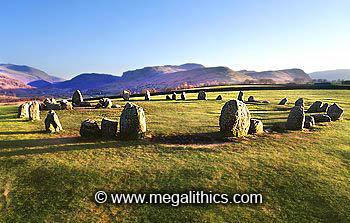
 |
Photo Gallery |
|
Panoramas |
||
Rock Art? |
||
3D Vision |
| NY 29141 23631 (GPS 1hr 20min). | Diameter 30.5m x 28.7m (Meas.) |
| Visited - many times | No magnetic anomalies |
Castlerigg is quite probably one of the
oldest stone circles in Europe, the circle is estimated to have been constructed
around
3200BC and bears many of the characteristics typical of early circles. Situated
on Chestnut Hill about 2km east of Keswick, the circle itself is spectacular and
the site has marvelous panoramic
views in all directions.
Castlerigg is also known as The Carles (the husbandmen), and many have taken this as
evidence of yet another human petrification legend associated with a
stone circle. In fact, the name comes from a misreading of an account by
Stukeley of a visit to the circle in 1725 in which he cites a local name of
"Carfles", the "f" in the word being an old English
"s".
The layout is a flattened ring with 38 of an estimated 42 original stones still
present, in addition, ten further stones form a rectangle 4.4m x 8.8m known as
"The Cave" which projects
into the circle interior at the SE. This type of internal construction in a
stone circle is very unusual and there is no indication of what its original
function may have been. The tallest stone in the circle stands close to the
stone rectangle at the SE, this stone is 2.5m tall and is estimated to weigh 16
tons, it is set radially to the circle circumference and is aligned to the
Samhain sunrise. The circle has a wide entrance at the north flanked by two
portal stones, these are both substantial blocks about 1.7m high.
Until quite recently Castlerigg was thought to have no rock art, but now
carvings have been reported on up to five of its stones. We have examined the
supposed carvings and we have to say that we remain unconvinced by most of them.
Whilst looking very impressive in published drawings, only one of the "carvings"
appeared artificial to us. For more information and photos click on the
"Rock Art" button above.
An outlier
stands 90m to the SW by the field wall, it had been used for many years as a
stile before being set upright in 1913. This stone bears many plough marks on
one face and was probably cleared to the field edge when
the field was under cultivation, its relationship to the circle (if any), is unknown.
Examination of the site revealed the remains of 2-3 round cairns within the
northern half of the circle, these are about 3m in diameter they are very low
features today and hard to make out. The cairns probably represent reuse of the site by
later people, an incorporation of the circle into their funerary practices.
There is a another Cumbrian circle with many similarities to Castlerigg and this
is Swinside. Swinside is about the same
diameter as Castlerigg with stones of roughly the same size, it too has an
entrance, this time denoted by double portal stones, the two circles are also in
roughly the same state of preservation.
Castlerigg is now in state care and lies only a 100m from the road, making it very accessible. The easy access is not without its downside however, this circle has very high media visibility and must feature in virtually every tourist guide to the Lake District. In the summer months the circle receives a veritable horde of visitors, many using the stones as seats or tables, so don't expect to enjoy the delights of Castlerigg in solitude!